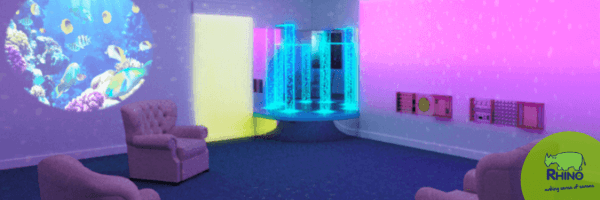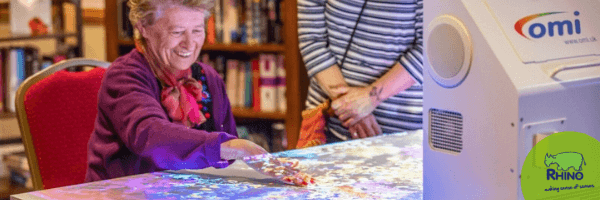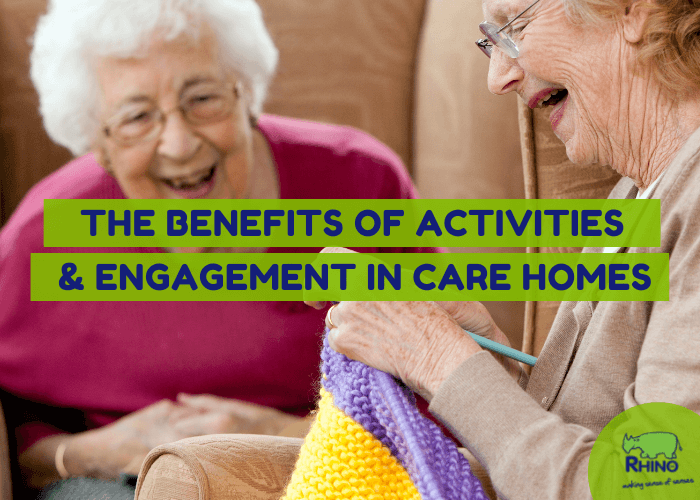After 18 months of limited contact, connections and conversations, there has never been a greater need for enriching engagement for residents in care homes. According to a recent study, one in six over 65-year-olds admitted that they were more worried about loneliness than they were Covid-19, highlighting the threat of a new wellbeing epidemic across the care sector.
Just like remembering to make sure you’ve always got a mask and a bottle of hand sanitiser on hand, there are lots of simple steps that you can take in your care home to create stimulating, engaging, and encouraging environments for your residents. Carry on reading to find out what you can do and how improving engagement could not only benefit the wellbeing of your residents but your staff and your care home too.
Person Centred Care
Before the coronavirus epidemic hit, there had been a growing push toward engagement led care plans in care homes. ‘Person Centred Care’ was a strategy introduced by the Department of Health in 2013 to encourage care homes to offer residents the same level of support as they would if they were living in their own homes. It’s a concept that expects residents to be treated like the individuals they are, where considerations about their history, personality, and abilities are used to craft bespoke care plans that will effectively support their mental and physical health.
Meaningful Activities
A 2019 study researching care plans in care homes found that 60% of respondents believed that by 2023 their main treatment focus would be wellbeing over the provision of care based only on diagnosis. Stemming from this is the recent trend in Meaningful Activities.
Meaningful Activities are defined by how they help a resident live each day with purpose. Whether that’s looking after the flowers in their garden, organising a monthly coffee morning to raise money for a local charity, or creating a memory box filled with treasured items. They can be big or small, exciting or practical, social or individual, but what’s most important is that they’re personal.
Meaningful Activities are most effective when they’re personal and aligned with residents’ hobbies and interests; active, where residents can physically interact with something instead of passively experiencing it; and routine, to provide structure and comfort. For example, you may have a resident who once played a prominent role in their local horticultural society; by giving them the opportunity to take care of the flowers in your garden, you’re motivating them regularly go outside and physically tend to the plants. What’s best is that they’ll have something impressive to show for their time working on the plot, instilling a sense of purpose and pride in themselves, which is crucial for supporting health and wellbeing.
Although, purpose is a lot more than personal pride and a short-term wellbeing boost. A 2012 study by the Rush Memory and Aging Project found that care home residents with dementia or other cognitive disabilities who felt they had purpose had a slower rate of cognitive decline and a lower risk of mortality, highlighting the importance of wellbeing not only from a therapeutic position but from a clinical position too. So much so that now in the US, one indication of care home quality is the extent to which residents engage in meaningful activities, proving its prevalence in care.

Engagement, Entertainment & Meaningful Activities
As the gardening example mentioned before, meaningful activities aren’t necessarily difficult or expensive to set up. Some of the best ones are the simplest ones – here are some stimulating ideas.
For Socialising: ‘Knit and Chat’ Sessions
Knit and Chat sessions are as simple as they sound; all you need are friends, knitting supplies and maybe a couple of cheeky chocolate biscuits. It’s a therapeutic social exercise that involves residents sitting together, knitting, and chatting. Whilst bonding over their shared interests, residents have the opportunity to learn more about their fellow peers, helping them to feel more connected and a part of their care home community and boosting their mental wellbeing.
Knitting is also an excellent activity for those with degenerative mental conditions such as Alzheimer’s or Dementia, as it relies on muscle memory rather than cognitive memory. Once you’ve picked up a complex physical skill like knitting, you’re unlikely to forget it, which is great for residents who don’t feel confident with their memory. The motion of knitting also activates and develops fine motor skills, which can make residents feel more confident and stronger in their movements and help maintain their independence when holding, lifting, or moving objects.
What’s best is that Knit and Chat sessions can be opened up to the local community for a more wholesome collaborative knitting session. Inviting friends, family, and community members into your care home is a great way to help residents feel less isolated and more connected to those around them. This sort of community-creating activity is actively encouraged by charities like the Alzheimer’s Society, which champion the interconnectivity of care homes and their communities. And to further their prevalence, CQC Guidelines support and encourage care home/community interconnectivity too. Therefore, not only are community knit and chat sessions likely to uplift residents’ moods and minds, but they are also likely to uplift your care home rating too!
For Reminiscence: Reminiscence Therapy
It’s very easy to lose your sense of self when you are removed from your home environment and placed into a clinical space; big moves like this are especially distressing for residents with Dementia or Alzheimer’s. To try and reverse these anxious effects, it’s essential to try and make your care environment as comfortable and familiar as possible. Reminiscence Therapy could be a great place to start.
Reminiscence Therapy is centred around conversation, storytelling, and personal memories. In these interactive therapy sessions, residents are encouraged to use photographs and objects to retell and relive some of their most fond memories. Throughout this process, residents can open up about their lives, share their stories and re-connect with their past selves.
There are lots of ways to support reminiscence therapy sessions. For example, Sensory Projectors can be used to cast old images and videos onto larger surfaces, helping residents feel more connected to their past; vintage board games can be used for a nostalgic games’ afternoon; whilst a morning spent making Memory Boxes filled with precious trinkets and personal items, can be used by residents as a reminder of who they are.
Not only can reminiscence activities help residents feel connected to themselves, but they can also help them to connect to those around them. For example, residents in your home have likely grown up through the same periods of history – whether that’s remembering the Queen’s coronation or watching the first-ever broadcast of Coronation Street – and sitting down and sharing these experiences is likely to bring your residents closer to one another. These growing connections will likely help the sense of community within your home blossom, transforming a once clinical space into a warm home environment.

For Getting Active: Chair Yoga
Chair Yoga is a highly recommended activity for care home environments, as it’s effective at boosting the mental and physical health of those who aren’t the most mobile. Carefully planned yoga exercises done from the seat of a chair encourages gentle movement that releases endorphins and increases blood flow, helping residents maintain muscle and feel more confident in how their bodies move.
Group yoga sessions might help alleviate the awkwardness that could come with an individual yoga session and encourage those who might have been too shy to participate.

For Relaxing: Sensory Therapy
Active Activities like knitting or yoga may not be the only way to engage your residents; calmer passive activities such as listening to music or sitting in a room illuminated by calming mood lighting could be a more effective way to engage residents. The idea behind this concept is Sensory Therapy, where senses are used to relax the body and the mind.
Senses are the way we experience and understand the world around us. Without them, things can seem dull and grey. For example, think about when you’ve had a cold and lost your sense of taste, and you find that the experience of eating food suddenly goes from enjoyable to incredibly functional. Likewise, in our later years, our sensory systems become less sensitive to outside stimulants (e.g. needing to turn up the volume on your TV to properly hear it), and the world can unwillingly become greyer. Sensory therapy stimulates these under-stimulated senses, uplifts moods, and adds colour to residents’ sensory landscapes.
Just like our senses, Sensory Therapy is multifaceted. There are many ways to effectively stimulate residents ‘ senses, from specially designed multisensory rooms filled with soft furnishings and interactive resources to smaller handheld devices and homemade therapies. Here are two simple ways you could try today.
Mood Lighting
Bright white lights are commonplace in care facilities, they’re practical, but they’re also troublesome, affecting energy levels and sometimes causing migraines. Mood Lighting is an easy and effective way to transform rooms and transfix minds colourfully. Blue, red, and purple lighting can calm residents, whereas greens, oranges and pinks can energise and uplift moods. Mood lighting is also helpful in expressive therapeutic activities, where residents express how they’re feeling through their choice of coloured lighting. It allows carers to get a better idea of their mood and mental health, helping to guide activities that suit their moods and emotions.
Sensory Spas
Bringing a sensory spa to your care home is another practical way to provide engaging, therapeutic activities for your residents. Hand rubs, foot rubs, back massages and facial treatments provide excellent tactile and proprioceptive input, which can be effective at calming muscles, relieving pain, and helping residents feel comfortable and present in their bodies.
You can easily create a more immersive sensory spa experience by stimulating more of bodies senses, like turning down the lights (visual), playing calming music (sound), and using scented oils with the massage treatments (smell). These simple elements brought together help to create a special and personal experience that will make your residents feel important and cared for.
Discover more Sensory Stimulation Activities for Adults.

Best All-Rounder: Interactive Projectors
Technology is great at keeping us connected to our friends and family, and it’s also great at keeping us connected to ourselves. Interactive projection isn’t an entirely new concept, but its implementation in care home therapy is starting to gain traction, and there are many good reasons why.
All interactive projectors need to work is a flat space and movement, which gives care environments the flexibility and freedom to project and play wherever best suits their residents, whether that’s on top of a table in the community activity room or directly on top of a resident’s bed. They also come pre-loaded with a library of inclusive games and activities that are designed to support therapeutic movement and improve mental and emotional wellbeing.
Calming interactive activities effectively distract minds and softly encourage movement, as they reward users for their actions. For example, a flower garden activity requires users to wave their hands across a field of flowers to help them bloom. Visual activities like these have encouraged even the most withdrawn residents to express themselves and connect with others, boosting their wellbeing.
On the other hand, active games encourage the development of motor skills and cognitive thinking, whether that’s over a friendly game of ping-pong or a melodic moment on a piano. In addition, the projection effects can instil a sense of confidence in those who may not be able to interact so freely in the physical world, e.g. slowed down ping-pong balls and giant piano keys. A 2020 study by Care Research into the effects of interactive projectors in care homes found that 90% of respondents reported that interacting with a projector positively impacted residents’ physical ability and movements. Whilst a further 80% agreed that the technology had provided more quality social time.
For all the benefits that they can bring, interactive projectors are a worthwhile investment. The same Care Research project found that 85% of respondents used their interactive projector every week and that 39% used it every day, highlighting their functionality in care settings and how they provide engaging, personalised care.

Conclusion
Creating opportunities for meaningful activities takes time, resources, and a whole effort from your care team. It’s not something that can be implemented overnight and can take weeks or even months to start running effectively and smoothly but remember that time effort will be worth it.
